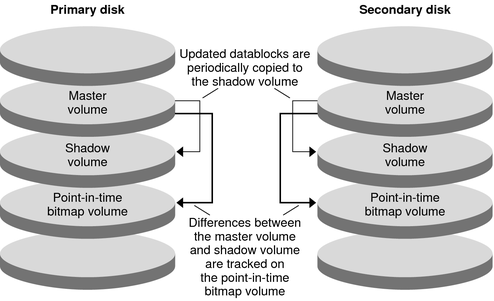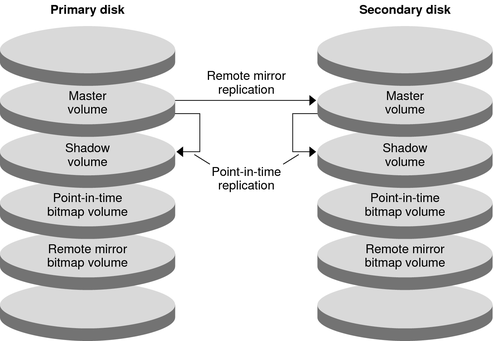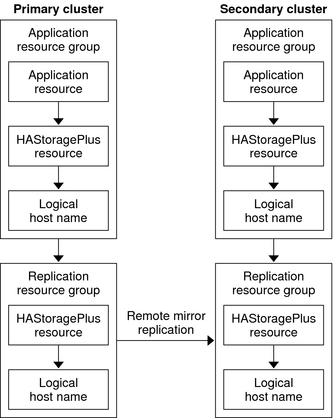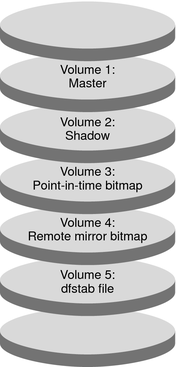| Skip Navigation Links | |
| Exit Print View | |

|
Oracle Solaris Cluster System Administration Guide |
1. Introduction to Administering Oracle Solaris Cluster
2. Oracle Solaris Cluster and RBAC
3. Shutting Down and Booting a Cluster
4. Data Replication Approaches
5. Administering Global Devices, Disk-Path Monitoring, and Cluster File Systems
7. Administering Cluster Interconnects and Public Networks
10. Configuring Control of CPU Usage
11. Patching Oracle Solaris Cluster Software and Firmware
12. Backing Up and Restoring a Cluster
13. Administering Oracle Solaris Cluster With the Graphical User Interfaces
Configuring Host-Based Data Replication With Sun StorageTek Availability Suite Software
Understanding Sun StorageTek Availability Suite Software in a Cluster
Data Replication Methods Used by Sun StorageTek Availability Suite Software
Replication in the Example Configuration
Guidelines for Configuring Host-Based Data Replication Between Clusters
Configuring Replication Resource Groups
Configuring Application Resource Groups
Configuring Resource Groups for a Failover Application
Configuring Resource Groups for a Scalable Application
Guidelines for Managing a Failover
Task Map: Example of a Data Replication Configuration
Connecting and Installing the Clusters
Example of How to Configure Device Groups and Resource Groups
How to Configure a Device Group on the Primary Cluster
How to Configure a Device Group on the Secondary Cluster
How to Configure the File System on the Primary Cluster for the NFS Application
How to Configure the File System on the Secondary Cluster for the NFS Application
How to Create a Replication Resource Group on the Primary Cluster
How to Create a Replication Resource Group on the Secondary Cluster
How to Create an NFS Application Resource Group on the Primary Cluster
How to Create an NFS Application Resource Group on the Secondary Cluster
Example of How to Enable Data Replication
How to Enable Replication on the Primary Cluster
How to Enable Replication on the Secondary Cluster
Example of How to Perform Data Replication
How to Perform a Remote Mirror Replication
How to Perform a Point-in-Time Snapshot
How to Verify That Replication Is Configured Correctly
This appendix provides an alternative to host-based replication that does not use Oracle Solaris Cluster Cluster Geographic Edition. Oracle recommends that you use Oracle Solaris Cluster Geographic Edition for host-based replication to simplify the configuration and operation of host-based replication within a cluster. See Understanding Data Replication.
The example in this appendix shows how to configure host-based data replication between clusters using Sun StorageTek Availability Suite 4.0 software. The example illustrates a complete cluster configuration for an NFS application that provides detailed information about how individual tasks can be performed. All tasks should be performed in the global-cluster voting node. The example does not include all of the steps that are required by other applications or other cluster configurations.
If you use role-based access control (RBAC) instead of superuser to access the cluster nodes, ensure that you can assume an RBAC role that provides authorization for all Oracle Solaris Cluster commands. This series of data replication procedures requires the following Oracle Solaris Cluster RBAC authorizations if the user is not superuser:
solaris.cluster.modify
solaris.cluster.admin
solaris.cluster.read
See the System Administration Guide: Security Services for more information about using RBAC roles. See the Oracle Solaris Cluster man pages for the RBAC authorization that each Oracle Solaris Cluster subcommand requires.
This section introduces disaster tolerance and describes the data replication methods that Sun StorageTek Availability Suite software uses.
Disaster tolerance is the ability of a system to restore an application on an alternate cluster when the primary cluster fails. Disaster tolerance is based on data replication and failover. Failover is the automatic relocation of a resource group or device group from a primary cluster to a secondary cluster. If the primary cluster fails, the application and the data are immediately available on the secondary cluster.
This section describes the remote mirror replication method and the point-in-time snapshot method used by Sun StorageTek Availability Suite software. This software uses the sndradm(1RPC) and iiadm(1II) commands to replicate data.
Figure A-1 shows remote mirror replication. Data from the master volume of the primary disk is replicated to the master volume of the secondary disk through a TCP/IP connection. A remote mirror bitmap tracks differences between the master volume on the primary disk and the master volume on the secondary disk.
Figure A-1 Remote Mirror Replication

Remote mirror replication can be performed synchronously in real time, or asynchronously. Each volume set in each cluster can be configured individually, for synchronous replication or asynchronous replication.
In synchronous data replication, a write operation is not confirmed as complete until the remote volume has been updated.
In asynchronous data replication, a write operation is confirmed as complete before the remote volume is updated. Asynchronous data replication provides greater flexibility over long distances and low bandwidth.
Figure A-2 shows point-in-time snapshot. Data from the master volume of each disk is copied to the shadow volume on the same disk. The point-in-time bitmap tracks differences between the master volume and the shadow volume. When data is copied to the shadow volume, the point-in-time bitmap is reset.
Figure A-2 Point-in-Time Snapshot

Figure A-3 illustrates how remote mirror replication and point-in-time snapshot are used in this example configuration.
Figure A-3 Replication in the Example Configuration

This section provides guidelines for configuring data replication between clusters. This section also contains tips for configuring replication resource groups and application resource groups. Use these guidelines when you are configuring data replication for your cluster.
This section discusses the following topics:
Replication resource groups collocate the device group under Sun StorageTek Availability Suite software control with the logical hostname resource. A replication resource group must have the following characteristics:
Be a failover resource group
A failover resource can run on only one node at a time. When a failover occurs, failover resources take part in the failover.
Have a logical hostname resource
The logical hostname must be hosted by the primary cluster. After a failover, the logical hostname must be hosted by the secondary cluster. The Domain Name System (DNS) is used to associate the logical hostname with a cluster.
Have an HAStoragePlus resource
The HAStoragePlus resource enforces the failover of the device group when the replication resource group is switched over or failed over. Oracle Solaris Cluster software also enforces the failover of the replication resource group when the device group is switched over. In this way, the replication resource group and the device group are always colocated, or mastered by the same node.
The following extension properties must be defined in the HAStoragePlus resource:
GlobalDevicePaths. This extension property defines the device group to which a volume belongs.
AffinityOn property = True. This extension property causes the device group to switch over or fail over when the replication resource group switches over or fails over. This feature is called an affinity switchover.
ZPoolsSearchDir. This extension property is required for using ZFS file system.
For more information about HAStoragePlus, see the SUNW.HAStoragePlus(5) man page.
Be named after the device group with which it is colocated, followed by -stor-rg
For example, devgrp-stor-rg.
Be online on both the primary cluster and the secondary cluster
To be highly available, an application must be managed as a resource in an application resource group. An application resource group can be configured for a failover application or a scalable application.
Application resources and application resource groups configured on the primary cluster must also be configured on the secondary cluster. Also, the data accessed by the application resource must be replicated to the secondary cluster.
This section provides guidelines for configuring the following application resource groups:
In a failover application, an application runs on one node at a time. If that node fails, the application fails over to another node in the same cluster. A resource group for a failover application must have the following characteristics:
Have an HAStoragePlus resource to enforce the failover of the device group when the application resource group is switched over or failed over
The device group is colocated with the replication resource group and the application resource group. Therefore, the failover of the application resource group enforces the failover of the device group and replication resource group. The application resource group, the replication resource group, and the device group are mastered by the same node.
Note, however, that a failover of the device group or the replication resource group does not cause a failover of the application resource group.
If the application data is globally mounted, the presence of an HAStoragePlus resource in the application resource group is not required but is advised.
If the application data is mounted locally, the presence of an HAStoragePlus resource in the application resource group is required.
Without an HAStoragePlus resource, the failover of the application resource group would not trigger the failover of the replication resource group and device group. After a failover, the application resource group, replication resource group, and device group would not be mastered by the same node.
For more information about HAStoragePlus, see the SUNW.HAStoragePlus(5) man page.
Must be online on the primary cluster and offline on the secondary cluster
The application resource group must be brought online on the secondary cluster when the secondary cluster takes over as the primary cluster.
Figure A-4 illustrates the configuration of an application resource group and a replication resource group in a failover application.
Figure A-4 Configuration of Resource Groups in a Failover Application

In a scalable application, an application runs on several nodes to create a single, logical service. If a node that is running a scalable application fails, failover does not occur. The application continues to run on the other nodes.
When a scalable application is managed as a resource in an application resource group, it is not necessary to collocate the application resource group with the device group. Therefore, it is not necessary to create an HAStoragePlus resource for the application resource group.
A resource group for a scalable application must have the following characteristics:
Have a dependency on the shared address resource group
The nodes that are running the scalable application use the shared address to distribute incoming data.
Be online on the primary cluster and offline on the secondary cluster
Figure A-5 illustrates the configuration of resource groups in a scalable application.
Figure A-5 Configuration of Resource Groups in a Scalable Application

If the primary cluster fails, the application must be switched over to the secondary cluster as soon as possible. To enable the secondary cluster to take over, the DNS must be updated.
The DNS associates a client with the logical hostname of an application. After a failover, the DNS mapping to the primary cluster must be removed, and a DNS mapping to the secondary cluster must be created. Figure A-6 shows how the DNS maps a client to a cluster.
Figure A-6 DNS Mapping of a Client to a Cluster

To update the DNS, use the nsupdate command. For information, see the nsupdate(1M) man page. For an example of how to manage a failover, see Example of How to Manage a Failover.
After repair, the primary cluster can be brought back online. To switch back to the original primary cluster, perform the following tasks:
Synchronize the primary cluster with the secondary cluster to ensure that the primary volume is up-to-date.
Update the DNS so that clients can access the application on the primary cluster.
Table A-1 lists the tasks in this example of how data replication was configured for an NFS application by using Sun StorageTek Availability Suite software.
Table A-1 Task Map: Example of a Data Replication Configuration
|
Figure A-7 illustrates the cluster configuration the example configuration uses. The secondary cluster in the example configuration contains one node, but other cluster configurations can be used.
Figure A-7 Example Cluster Configuration

Table A-2 summarizes the hardware and software that the example configuration requires. The Oracle Solaris OS, Oracle Solaris Cluster software, and volume manager software must be installed on the cluster nodes before Sun StorageTek Availability Suite software and patches are installed.
Table A-2 Required Hardware and Software
|
This section describes how device groups and resource groups are configured for an NFS application. For additional information, see Configuring Replication Resource Groups and Configuring Application Resource Groups.
This section contains the following procedures:
How to Configure the File System on the Primary Cluster for the NFS Application
How to Configure the File System on the Secondary Cluster for the NFS Application
How to Create a Replication Resource Group on the Primary Cluster
How to Create a Replication Resource Group on the Secondary Cluster
How to Create an NFS Application Resource Group on the Primary Cluster
How to Create an NFS Application Resource Group on the Secondary Cluster
The following table lists the names of the groups and resources that are created for the example configuration.
Table A-3 Summary of the Groups and Resources in the Example Configuration
|
With the exception of devgrp-stor-rg, the names of the groups and resources are example names that can be changed as required. The replication resource group must have a name with the format devicegroupname-stor-rg.
This example configuration uses VxVM software. For information about Solaris Volume Manager software, see the Chapter 4, Configuring Solaris Volume Manager Software, in Oracle Solaris Cluster Software Installation Guide.
The following figure illustrates the volumes that are created in the device group.
Figure A-8 Volumes for the Device Group

Note - The volumes that are defined in this procedure must not include disk-label private areas, for example, cylinder 0. The VxVM software manages this constraint automatically.